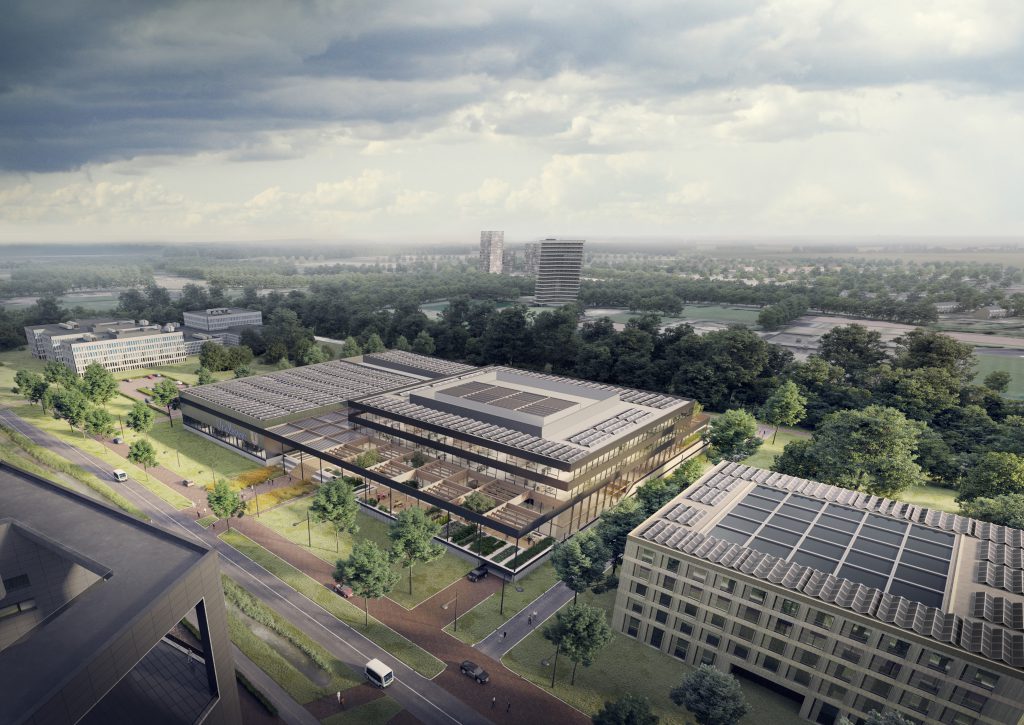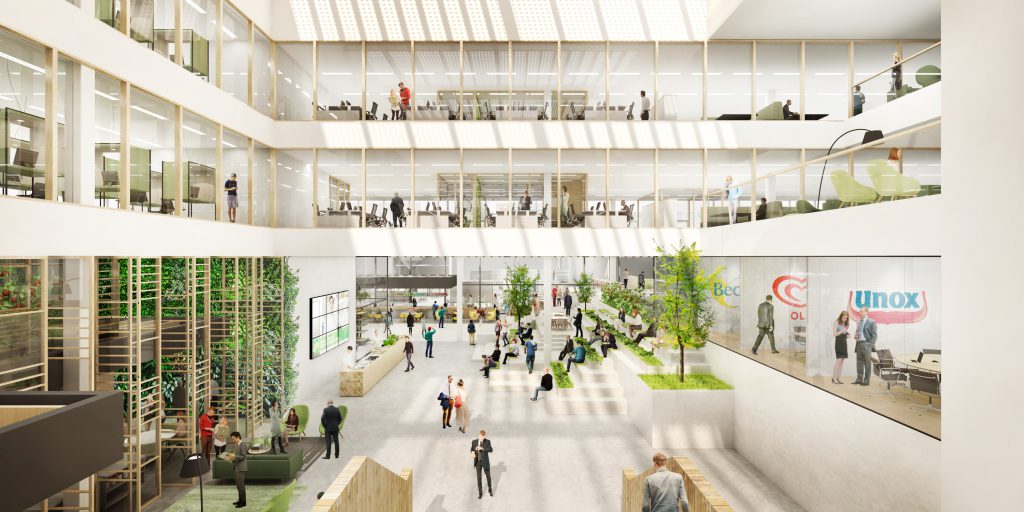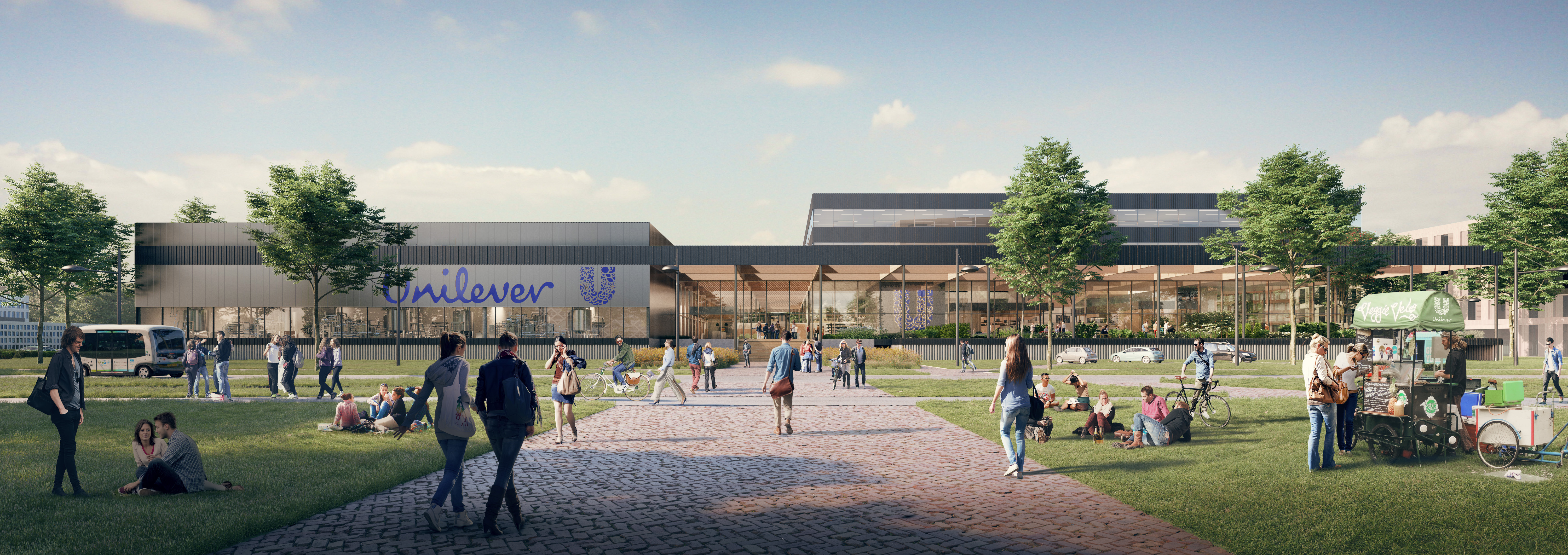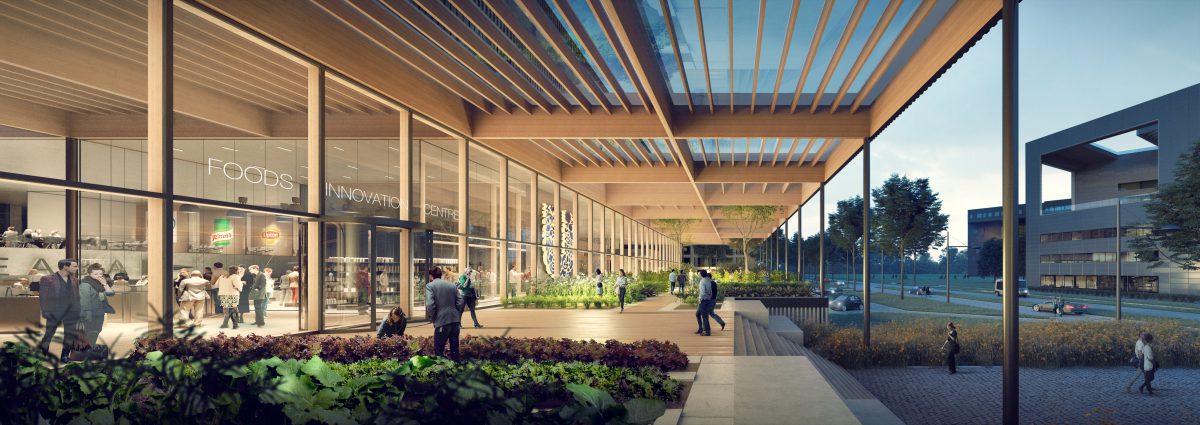The Global Foods Innovation Centre is an inspiring, sustainable, and practical building that facilitates innovative ways of collaborating

Project Details
- Scheme & Version: NL New Build and Renovation
- Stage: Interim
- Location: Netherlands
- Score & Rating: 91.2% Oustanding
- Certificate Number: 694-NBN-2014
Project Team
- Client: Unilever Research & Development BV
- Contractor: Dura Vermeer
- Construction Management: Arcadis
- Architect: Paul de Ruiter Architects
- Interior Architect: Fokkema & Partners
- BREEAM Assessor: W4Y Adviseurs B.V.
Unilever’s Purpose
Every day, 2.5 billion people use Unilever products to feel good, look good and get more out of life. With more than 400 brands bought in 190 countries, we have a unique opportunity to work with consumers to make sustainable living commonplace.
Unilever’s vision is to grow our company, while decoupling our growth from our environmental footprint and increasing our positive social impact. This vision connects us with the companies that have established us and their social missions to improve health, hygiene, and the living standards of their communities. We believe that companies must make a positive contribution to the challenges the world faces and that this is the only way a company can be successful. In 2009, we started “The Compass” – our Sustainable Growth Strategy with which we want to build a sustainable company for the long term.
The Unilever Sustainable Living Plan, launched in 2010, created the blueprint for achieving this strategy. We continue to work on our ambitious goals for halving our impact on the environment, improving the health and well-being of 1 billion people, and improving the living standards of millions.
Transforming the Global Food System
The way the world produces and consumes food today is unsustainable. From over-exploitation and climate change, to waste and poor diets, the food system needs fixing. With increasing population that could reach 9 billion people by 2050, the world needs to increase food production by 60%. Today, around one in nine people – 800 million – go to bed hungry every night. Meanwhile, one-third of food is never eaten. That’s the equivalent of sub-Saharan Africa’s entire annual harvest, costing the global economy $750 billion and 3.3 billion tonnes of greenhouse gases.
We believe global food systems have to change, to better serve farmers and their communities, the planet, and the people who buy our brands. The issues are complex and interconnected and cannot be solved by addressing food production or consumption separately. To transform the foods system on a global-scale, close collaboration with governmental institutions, universities, startups, companies and knowledge centers is required. And that is why we are building a new Global Foods Innovation Centre at the Wageningen University Campus in The Netherlands, one of the world’s most renowned agri-food ecosystems. The new Global Foods Innovation Centre will strengthen Unilever’s ability to develop cutting edge sustainable food innovations in close collaboration with others.
Why did this building undergo BREEAM Certification?
The BREEAM certification has been used to make construction-sustainability measurable and comparable. Not as an end goal but rather to realize a truly future-proof building.
Central in realizing a BREEAM Outstanding certification is assuring high user quality and user value. In our vision, this includes managing health and comfort, energy consumption, flexibility, and guaranteeing performance. As part of this, we see the BREEAM method as a globally recognized, credible guideline throughout the design & building process with which we achieve integrated solutions. As such, the Global Foods Innovation Center received BREEAM Outstanding Certification for its design, with a score of 91,23%.
“BREEAM certification helps Unilever to realize a Global Foods Innovation Centre that is truly future-proof and that maximizes user-value. Throughout the process, the BREEAM guides us towards more integrated solutions that makes the building healthier and better-suited to its users, expandable and adaptable, and will return more value in the long run. This makes the BREEAM certification for Unilever Global Foods Innovation Centre a perfect fit with our mission to grow our company, whilst reducing our environmental footprint and increasing our positive social impact.”
Building Concept
The new Global Foods Innovation Centre will be an inspiring, sustainable, and practical building that facilitates innovative ways of collaborating. The building’s transparent design and its strategic location on the university campus ensure optimum interaction between Unilever and various relevant external parties. Knowledge-sharing is built into the design. Researchers and students from Wageningen University (WUR), start-ups, knowledge centers, and consumers will be able to meet here and work together in a sustainable manner on innovations in the food industry.
The Global Foods Innovation Centre consists of a Pilot Plant, a Food & Customer Experience area, and two floors of offices and laboratories. The Pilot Plant will be a mini factory for the small-scale production of new products. This mini factory will link directly to the Food & Customer Experience area, where test kitchens will be home to daily experimentation with innovative ingredients for the development of new products. Employees, experts, students, and consumers can try the new products and share their views here or in the concept store.
A light-filled atrium with a skylight and a wide wooden staircase will connect Unilever’s offices and laboratories with the public area on the ground floor. The perimeter of the entire facility will continue underground, where it will become the boundary of a vast car park for use by employees of both Unilever and Wageningen University.
Sustainability Ambition
At commissioning, the building aspires to meet the highest sustainability standards and circular economy principles. The Innovation Center contributes to the health and well-being of its users through various innovative techniques and a refined layout, in which movement and meeting are stimulated. The new building is an opportunity to manifest the norms, values, and ambitions of Unilever in a physical environment. We want to inspire the world with sustainable, higher-level innovations for health and nutrition.

Overview of Green Strategy and Environmental Features
Throughout the process, the BREEAM guides us towards more integrated solutions that makes the building healthier and better-suited to its users, expandable and adaptable, and will return more value in the long run.
Unique Features of the Building
The vision of a future-proof building has been divided into four themes: health, flexibility, energy usage, and material efficiency, and circularity. These themes are the basis for sustainability for the Global Foods Innovation Centre. By means of the following elaboration, it is made clear how the themes have been converted into the design of a sustainable, healthy, and flexible building.
Connective Building Design
We have created a connective building for Unilever that maximizes the links between employees, both visually and physically. The power and intelligence of an organization are enhanced when people can work together in an inspired way. The building promote spontaneous encounters between the work processes by means of transparency, strategic informal meeting places such as coffee corners, and the wide staircases that will encourage people to travel between floors.
Health
A sustainable building offers a healthy and comfortable working environment for all building users. Health is a primary condition for working well and effectively. In a healthy building, there is less absenteeism and productivity are demonstrably higher. Health is not just about heat and cold. It is also about (day) light, views of green, air quality, acoustics, and a functional and ergonomic workplace.
Energy Usage
Sustainable buildings have a low energy consumption. This is achieved in the design by the following measures:
- A compact design so that energy losses are reduced;
- An optimized façade, creating a balance between the maximum entry of daylight, light protection, and the prevention of heat loss;
- Very airtight construction;
- Heat recovery from ventilation air;
- Maximum control of the installations based on user requirements and presence (presence detection / CO2 monitoring): the occupancy and usage times in the building will vary considerably. Significant energy gains will be made by matching the use and the occupancy rate of the building with the operation of the installations;
- All lighting is LED and equipped with sensors for presence and daylight. The sensors are also used to regulate the climate.
Sustainable buildings can provide their own energy needs. An all-electric energy concept was chosen in which air-cooled heat pumps and water-cooled heat pumps (in combination with heat-cold storage in the ground) provide the cold and heat demand of the building. The roof surface is maximally used for installing over 1800 PV panels to ensure energy neutrality.
Material Selection and Circularity
A sustainable building is circular and handles materials and raw materials responsibly. The design has been implemented in various ways such as:
- Concrete building parts have a high percentage (up to 30%) of recycled aggregates such as debris and concrete granules;
- All wood in the building is FSC certified and therefore has a sustainable origin;
- The building volume has been optimized to achieve the largest possible volume with as little material as possible;
- The interior has been developed separately from the hull so that it is possible to change without intervening measures;
- Building elements are designed to be disassembled, making it possible to reuse elements and raw materials in a simple manner when they are no longer needed in the current building.
- While not explicitly featured within BREEAM, integral to Unilever’s vision is the large-scale reuse of equipment and furniture of the current sites in the Global Foods Innovation Centre.
Innovations
By applying ionization of the outside air and controlling the building all through a multi-sensor system, innovations are added to the building that fit seamlessly with our vision of a future-proof building. Measurements in offices and factories show that with the current method of air treatment only 50% of the total amount of volatile organic constituents is removed from the indoor air, so that more ventilation capacity is needed, and bacteria and fungi can multiply more easily. By means of ionization of the air, the natural cleansing power of oxygen is used.
The operation of the multi-sensor system is based on thermographic measurement in a room. In contrast to traditional room temperature measurements, which are based on measuring the air temperature at a single location in the room, the infrared measuring system offers a complete and continuous picture of the thermographic properties of the (office) environment. Because of this measurement, it is possible to allow the installations to anticipate various changes in the room (temperature, occupancy, energy loss, heat sources).


